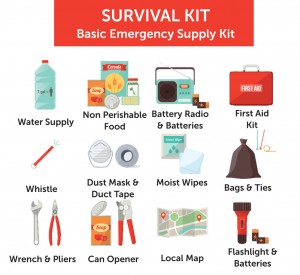In our area, the month of April traditionally marks the beginning of the severe weather season with some of the most damaging storms and deadly tornadoes occurring during this time of year and running through the summer.
Today’s technology gives meteorologists a new set of forecasting tools which allows them to predict potentially severe weather hours prior to or even days before it arrives. And while this technology has brought us even more ways to be prepared for and monitor severe weather, it’s still vital to have a pla n, which includes knowing what to do in case these technologies aren’t available due to damaged communication towers, extended power outages and several other factors.
n, which includes knowing what to do in case these technologies aren’t available due to damaged communication towers, extended power outages and several other factors.
The first step is having a disaster kit in the event you do not have access to food, water or electricity for a period of time. Even though it is unlikely that an emergency would cut off your food and water supplies for two weeks, consider maintaining a stockpile that will last that long. Also include a first aid kit, a supply of medications, a spare set of car keys and a copy of important documents such as insurance policies.
In case of a power outage, flashlights and extra, preferably new, batteries are essential, but don’t forget a battery powered radio and a manual can opener. If you know bad weather is possible, charge and store portable chargers that can be used for cell phones and tablets. Portable chargers that operate with alkaline batteries are also available and would make a great addition to your disaster kit.
Today’s technology makes communication easier than ever before— with phone, text, social media and location apps to help keep in touch with others during and after a disaster. But as many have experienced during events such as the April 2011 tornado outbreak that struck our state, these avenues can sometimes fail or be unavailable for extended periods of time. For this very reason, make sure you designate a family meeting place for shelter during and after a storm and have a pre-determined contact to serve as a communication point for all family members—preferably someone not in your immediate area that would not be impacted by a storm.
It is also advisable to have a printed copy of important and emergency contact information in the event you do not have access to your phone, tablet or computer—which many of us rely on to store this information. It’s also a good practice to back-up your computer’s files onto an external drive and store it in a secure place or take advantage of cloud-based backup services for your data.
Don’t forget useful apps that are also available. Weather tracking apps can keep you informed of severe weather no matter the time of day. Other apps are there to help with your storm preparation, such as those by the American Red Cross which give you instant access to first aid information, maps to opened Red Cross shelters and much more.
Countless lives have been saved from dangerous weather through the use of technology, and just as it should be a part of your disaster preparedness plan, you should also have a back-up plan ready in case the technology we have come to rely on is not available.
